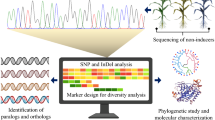Summary
Extracts from phylloclads of Asparagus officinails were electrophoretically analyzed for isozyme polymorphism. Fourteen enzyme systems were examined using four buffer systems: seven enzymes (acid phosphatase, catalase, glutamate-oxaloacetate transaminase, isocitrate dehydrogenase, malate dehydrogenase, peroxidase, and 6-phosphogluconate dehydrogenase) exhibited clear and consistent banding patterns. Isozyme polymorphism was studied in seven pairs of male and female doubled haploids and in their male F1s. Segregation of polymorphic loci was examined in the backcross progenies and was found to be consistent with a simple Mendelian inheritance in all cases, except for three anodical peroxidases, where two factors have been hypothesized. No linkage could be found between isozyme markers that were segregating in the same cross, but association was demonstrated between one malate dehydrogenase locus and the sex determining genes. The availability of isozyme markers may be useful in breeding and, in particular, the localization of one malate dehydrogenase locus on the sex chromosomes may be helpful in mapping the sex genes.
Similar content being viewed by others
References
Bracale M, Galli MG, Falavigna A, Soave C (1990) Sexual differentiation in Asparagus officinalis L. II. Total and newly synthesized proteins in male and female flowers. Sex Plant Reprod 3:23–30
Cardy BJ, Stuber CW, Wendel JF, Goodman MM (1983) Techniques for starch gel electrophoresis of enzymes from maize (Zea mays L.). Institute of Statistics Mimeograph Series No. 1317, North Carolina State University, Raleigh/NC
Falavigna A, Tacconi MG, Soressi GP (1983) Recent progress in asparagus (Asparagus officinalis L.) breeding by anther vitro cultures. Acta Hortic 131:215–222
Franken AA (1970) Sex characteristics and inheritance of sex in asparagus (Asparagus officinalis L.). Euphytica 19:277–287
Galli MG, Bracale M, Falavigna A, Soave C (1988) Sexual differentiation in Asparagus officinalis L. I. DNA characterization and mRNA activities in male and female flowers. Sex Plant Reprod 1:202–207
Gottlieb LD (1982) Conservation and duplication of isozymes in plants. Science 216:373–380
Graham RC, Lundholm U, Karnovsky MJ (1964) Cytochemical demonstration of peroxidase activity with 3-amino-9-ethylcarbazole. J Histochem Cytochem 13:150–152
Loptien H (1979) Identification of the sex chromosome pair in asparagus (Asparagus officinalis L.). Z Pflanzenzuecht 82:162–173
Marks M (1973) A reconsideration of the genetic mechanism for sex determination in Asparagus officinalis. Proc Eucarpia Meet Asparagus, Versailles, pp 122–128
Marziani Longo GP, Rossi G, Scaglione G, Longo CP, Soave C (1990) Sexual differentiation in Asparagus officinalis L. III. Hormonal content and isoperoxidases in female and male plants. Sex Plant Reprod 3:236–243
Peirce LC, Currence TM (1962) The inheritance of hermaphroditism in Asparagus officinalis L. Proc. Am Soc Hortic Sci 80:368–376
Rick LM, Hanna GL (1943) Determination of sex in Asparagus officinalis. Am J Bot 30:711–714
Roux L, Roux Y (1981) Identification biochimique de clones et de lignées d'asperge (Asparagus officinalis L., Liliacées). Agronomie 1:541–548
Scandalios JG (1969) Genetic control of multiple molecular forms of enzymes in plants: a review. Biochem Genet 3:37–79
Westergaard N (1958) The mechanism of sex determination in dioecious flowering plants. Adv Genet 9:217–281
Author information
Authors and Affiliations
Additional information
Communicated by F. Salamini
Rights and permissions
About this article
Cite this article
Maestri, E., Restivo, F.M., Marziani Longo, G.P. et al. Isozyme gene markers in the dioecious species Asparagus officinalis L.. Theoret. Appl. Genetics 81, 613–618 (1991). https://doi.org/10.1007/BF00226726
Received:
Accepted:
Issue Date:
DOI: https://doi.org/10.1007/BF00226726




